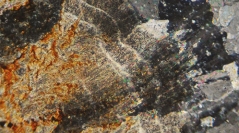

 Geodiversitas
44 (24) - Pages 665-682
Geodiversitas
44 (24) - Pages 665-682Lower Cretaceous deposits from the Charentes region, in southwestern France, correspond to Purbeckian facies of continental to brackish environments, locally rich in evaporitic formations (Manès 1850; Pouech et al. 2006, 2014, 2015; Schnyder et al. 2012; Vullo et al. 2014; Moreau et al. 2017b). Three fossiliferous localities have been previously identified: the Berriasian gypsum of Champblanc, near Cherves, with both teeth accumulations and bone beds of fishes, crocodiles and dinosaurs, but relatively poor in fossil wood (Buffetaut et al. 1989; Le Loeuff et al. 1996; Schnyder 2003; Colin et al. 2004; El Albani et al. 2004; Mazin et al. 2006; Rees et al. 2013); the Berriasian marls and calcareous conglomerate of Angeac-Charente, particularly rich in dinosaur megaremains and lignitic accumulations (Néraudeau et al. 2012; Allain et al. 2014; Benoît et al. 2017; Polette et al. 2018; Polette 2019); the Purbeckian to Wealden clay and conglomerate of the Rochefort area, providing large bones of dinosaurs in surface blocks, but never observed in stratigraphical position (Vullo et al. 2012). Another fossiliferous Purbeckian locality from the Charentes region, the Chassiron coast of Oleron Island, is rich in vertebrate and plant remains, but mainly Tithonian in age (Vullo et al. 2014; Moreau et al. 2017b).
SW France, Charente, Berriasian, fossil wood, calcite mineralization, carbonatization, Pubeckian facies, new combination